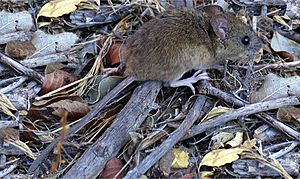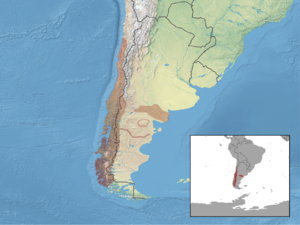Long-tailed colilargo facts for kids
Quick facts for kids Long-tailed colilargo |
|
|---|---|
 |
|
| Conservation status | |
| Scientific classification | |
| Genus: |
Oligoryzomys
|
| Species: |
longicaudatus
|
 |
|
The long-tailed colilargo (scientific name: Oligoryzomys longicaudatus) is a small rodent that lives in parts of South America. It's also called the long-tailed pygmy rice rat. This little mouse belongs to a group of rodents called Oligoryzomys within the Cricetidae family. You can find it in the southern Andes mountains, especially in Chile and Argentina. Scientists say it's a "least concern" animal, meaning its population is stable and not currently at risk.
Contents
What Does It Look Like?
The long-tailed colilargo is a small mouse. It grows to about 22 centimeters (around 9 inches) long, including its tail. The tail itself is quite long, about 13 centimeters (5 inches). This mouse usually weighs around 24 grams (less than an ounce), which is about the weight of a few quarters!
Its ears are small and have very few hairs. The tail also has few hairs and is dark on top and lighter underneath. The fur on its back is a light brown color with thin lines of pale brown and black. The fur on its belly is usually grayish-white. In some areas, like Argentina, its fur might have a hint of orange, especially on its sides.
Where Does It Live?
This mouse is a mountain animal native to southern South America. Its home stretches from northern Chile and northwestern Argentina down to Patagonia. You can find it living in forests, among bushes, and in other bushy areas.
In northern Chile, it's the most common small rodent found in the cloud forest. In Patagonia, it prefers open areas like clearings, roadsides, and scrubby places. It is often found in wetter spots, such as near rivers or lakes.
Life and Habits
The long-tailed colilargo is a good climber and can also jump well. Its diet changes depending on the time of year. During the dry season, it mainly eats seeds. But in the wet season, it prefers flowers, pollen, and leaves from plants like Chenopodium. Sometimes, it also eats insects.
Reproduction and Life Cycle
These mice can start having babies when they are only a few months old. They build their nests in bushes, often a few meters off the ground. Sometimes, they even use an old bird's nest! A female mouse can have babies three times a year. On average, she will have almost five young in each litter.
Population Swings
The number of long-tailed colilargo mice can change a lot. For example, in 1990, a huge area of bamboo plants in southern Chile flowered all at once. This event, called a "mass seeding," produced tons of seeds. Because there was so much food, the number of long-tailed colilargo mice exploded!
These increases in mouse numbers happen because more babies are born, more young mice survive, and the breeding season lasts longer. Since many bamboo seeds stayed on the plants until the next year, the mouse population stayed high for a while.
In 1997, many mice were found near Nahuel Huapi Lake in Argentina. Most of them were long-tailed colilargos. This was another big increase in their numbers. It took until the next year for the mouse population to return to normal.
Health Concerns
The long-tailed colilargo is the main animal that carries the Andes virus (ANDV). This virus can cause a serious illness in humans called hantavirus cardiopulmonary syndrome.
See also
 In Spanish: Ratón colilargo para niños
In Spanish: Ratón colilargo para niños


